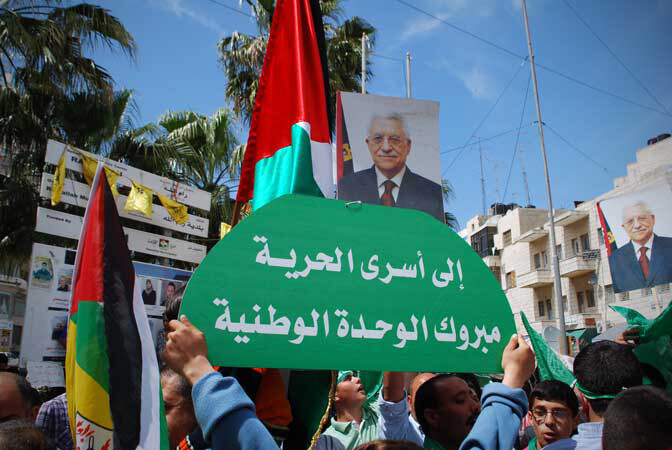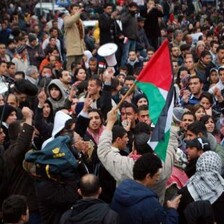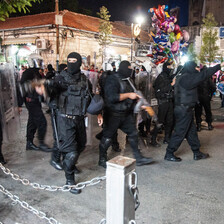The Electronic Intifada Ramallah 10 May 2011

Hamas supporters take to the streets of Ramallah for the first time since in four years, 6 May 2011.
On 6 May, news reporters, cameramen and bystanders gathered in al-Manara circle waiting for the end of Friday’s midday prayer at the Gamal Abdel Nasser Mosque, the largest mosque in Ramallah in the occupied West Bank. At 1:30pm, al-Manara was still hushed as spectators peered down al-Quds Street, hoping to catch sight of the first emerald green Hamas flag in Ramallah since the internal split in 2007.
When prayer ended, a small group consisting mostly of men made their way up the street, chanting “Hamas, Hamas.” Clad in green headbands, the group of approximately two hundred descended into al-Manara as if onto a stage, to celebrate the putative end of their banishment from the West Bank.
“I can’t even describe how big it is — to be able to speak freely, with no Hamas, Fatah and no Israel to prevent it,” said Akram Salima, a member of Hamas, who has spent time in both Israeli and Palestinian Authority prisons for his affiliation with the party.
The recently brokered unity agreement between Fatah and Hamas is the culmination of mounting pressure that began with the release of the Palestine Papers by Al Jazeera in January and was catalyzed by the uprisings in Egypt, Tunisia and the rest of the Arab world. As Palestinian historian Rashid Khalidi commented on the agreement, in a statement made available by the Institute for Middle East Understanding, “This is the first fruit for Palestine after the fall of Mubarak and the Arab Spring.”
Egyptian president Hosni Mubarak and his intelligence chief, Omar Suleiman, were two of the PA’s biggest supporters against Hamas. Their removal also served to inspire and instigate mobilization among Palestinian youth in the occupied West Bank and Gaza Strip. No longer did the status quo seem indomitable, and the prospect for real change appeared attainable by the Palestinian people and perhaps inevitable for the two major parties.
Call for unity
“Unity” became the rallying cry of Palestinian youth and protesters in Gaza and the West Bank, especially when they realized that any other demand directed at the governments of the two territories would be too contentious to be successful.
At the start of the Egyptian uprising, PA security forces immediately terminated solidarity demonstrations in Ramallah, affirming PA President Mahmoud Abbas government’s alliance with Mubarak and suggesting that it did not want Palestinians to catch the democratic bug themselves.
In early February, the solidarity demonstrations continued in Ramallah, under the strict but broad banner of calls for “unity,” as any utterances that placed blame on or criticized the PA would put participants at risk of arrest.
In March, these sporadic demonstrations transformed into a targeted youth campaign, employing a hunger strike to pressure governments to “end the division” and implement elections for the Palestinian National Council. As their demands gained attention, the PA began backpedaling on their unpopular repressive tactics and jumped on the opportunity to back unity as well.
In al-Manara on Friday, the crowd was small, but elated. Anas, 22, who declined to give his last name, was delighted and proud to express his support for Hamas and the unity agreement. “I’m very happy for the unity of our people because this unity makes the occupation harder,” he said. “We say our unity is the peace for our people, our Palestine. Our leaders want unity.”
Yet some remain unconvinced. Abed Alhafeez, a Palestinian journalist, commented as he watched the crowd gather, “This is the first time in four years to see the green flag in Ramallah — but in fact it means nothing.”
The agreement itself is short and does not indicate any concession either side is willing to make. The open waving of Fatah flags in Gaza and Hamas flags in the West Bank implies that direct political repression will cease. However, it remains to be seen what truly significant changes the unity agreement will engender or assure — such as the release of political prisoners held by both parties — an issue further complicated by the fact that both Fatah and Hamas have denied holding such prisoners.
One of the principal points of difference between the PA and Hamas is the issue of security, which the current agreement does not address. Hamas has long decried the cooperation of the PA’s General Intelligence Services with the US and Israel, and there is no indication the Fatah-controlled PA will change this policy.
Recent events have cast serious doubt on the actual freedom Hamas members will have in the occupied West Bank post-unification. After unification was announced, Ma’an News Agency reported that Israel arrested two members of Hamas in the West Bank. Furthermore, on 5 May, Reuters reported that the PA security forces detained six Hamas-affiliated men.
Alhafeez continued to explain the deep mistrust that has been sown into Palestinian society during four years of rampant political arrests, torture and profiling. “The split was like another Nakba [catastrophe] for Palestine. It will take years to repair.”
However, despite the fundamental uncertainties of the agreement, many are remaining optimistic.
Mazin Qumsiyeh, a political analyst, professor and author based in the West Bank, told The Electronic Intifada: “Anything that will move things from the status quo are good. Any kind of change is good. We have to realize the geo-political constructs are changing rapidly. No one can afford to keep the status quo. So I think it’s not possible for Hamas and Fatah to return to previous conditions.”
Back at the demonstration, Hamas supporter Ahmed Mubarat, 48, said that “We have to trust each other because there is no trust now — our leaders must release the political prisoners and let society be more open.”
15 March Youth Movement
Youth leaders from the 15 March movement, a loosely coalesced group of students and activists that have mobilized around unification between Fatah and Hamas and the reinstatement of the Palestinian National Council, are remaining cautious, and are determined to ensure the unity agreement does not stagnate into a power-sharing resolution.
Najwan Berekdar, a Palestinian activist from Nazareth, who helped organize unity protests in the West Bank, welcomes the move but warns against premature celebrations. “It’s a positive step — but now it means the role of youth is even bigger. We need to be aware of what is happening; we need to remain on the ground to keep the pressure on the government.”
Berekdar believes the movement she and others launched effectively frightened the PA and Hamas. “The youth movement — though not that big — was big for Palestine and scared them,” she said. “They were afraid of the bond between Palestinians [in Israel], Gaza and the West Bank.”
Speaking several days before the orchestrated unification, Fadi Quran, Berekdar’s colleague in mobilizing youth around unification in Ramallah, told The Electronic Intifada that calling for unity was perhaps hasty.
Quran emphasized the need to work at the grassroots level to build a solid national movement that is not only in the hands of the leaders. “What really matters is not people saying they want unity, but actually taking steps towards unity,” he said.
It appears that the vague unity agreement signed on 4 May signifies at least a new geopolitical landscape that is no longer hospitable to autocratic rule and at best an actual shift in the political will of Palestine’s strongmen. Either way, the agreement intimates that the leaders are listening and that is spurring Palestinian youth to increased action and mobilization.
Determined to keep the voice of the youth on the table, Berekdar said, “We will watch this process, keep doing what we were doing, and make sure the process goes the way we want it, not the way they want it.”
Charlotte Silver is a journalist based in the West Bank. She can be reached at charlottesilver A T gmail D O T com.





